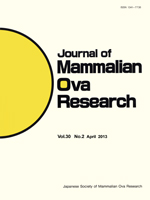We examined whether partial thinning of zona pellucida by a LAH (laser-assisted hatching) system in ICSI could ease pressure on the egg and influence the results of subsequent embryogenesis and pregnancy rate (90 subjects, 101 cycles). ICSI was performed with and without thinning of zona pellucida in a thinning group and a control group, respectively, and the results of embryogenesis and pregnancy rate were compared between the two groups. Fertilization rate, oocyte degeneration rate, good embryo rate, and pregnancy rate in early embryo implantation were higher, though not significantly in the thinning group (80.8%, 7.5%, 66.5%, and 28.6%) than in the control group (73.0%, 9.7%, 64.6%, and 23.1%). The fertilization rate was significantly higher in the thinning group compared to the control group. Our results suggest that partial thinning of zona pellucida using a LAH system is useful in ICSI.
How to translate text using browser tools
1 April 2013
The Usefulness of Partial Thinning of Zona Pellucida using a Laser-Assisted Hatching System in ICSI
Ikue Takahashi,
Akiko Hatori,
Hideyuki Nakano
ACCESS THE FULL ARTICLE
It is not available for individual sale.
This article is only available to subscribers.
It is not available for individual sale.
It is not available for individual sale.

Journal of Mammalian Ova Research
Vol. 30 • No. 2
April 2013
Vol. 30 • No. 2
April 2013
embryogenesis
Infrared laser system
Laser-assisted ICSI
Partial thinning of zona pellucida
Physical stress




